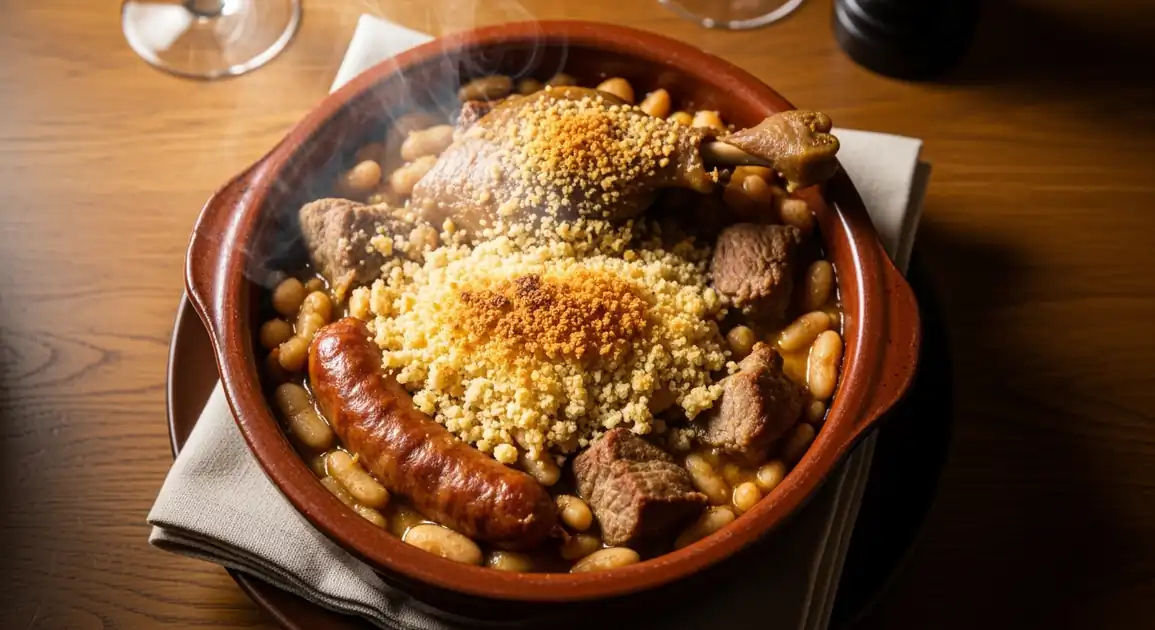Cassoulet
Cassoulet

Description
Paris, as France's culinary capital, offers numerous opportunities to taste excellent Cassoulet, particularly in bistros and restaurants specializing in traditional or Southwestern French cuisine. While not native to Paris, it's a beloved dish, especially during colder weather.
Dietary Information
Serving information
Serving style
Served as a main course ('plat principal'), typically in an individual earthenware dish, arriving very hot.
Quick facts
Lunch service typically 12 PM - 2:30 PM, Dinner service 7 PM - 10:30 PM or 11 PM. Some bistros may have continuous service.
Safety Tips
What to Look For
-
Served piping hot, ideally bubbling
Ensures the dish has been heated thoroughly to safe temperatures and is freshly served.
-
Reputable restaurant with good hygiene standards
Choose established restaurants known for quality French cuisine, reducing general food safety concerns.
-
Well-cooked, tender meats and creamy beans
Indicates proper preparation. Undercooked beans or tough meat suggest rushed cooking.
-
Dish smells fresh and savory
Trust your senses; the aroma should be rich and appealing, not sour or off.
What to avoid
-
Lukewarm or cold cassoulet
Incorrect serving temperature is a food safety risk and diminishes the quality of the dish.
-
Restaurants with poor cleanliness reviews or visible hygiene issues
General hygiene is crucial for food safety.
-
Undercooked beans (hard) or questionable meat quality
Signifies improper preparation which can impact safety and taste.
-
Cassoulet that seems overly watery or soupy
While not strictly a safety issue, it indicates a poorly made version lacking the proper richness and texture.
Price information
Price range
Budget tips
- Prices are generally higher in Paris than in the Southwest.
- Look for 'formule déjeuner' (set lunch menus) in bistros that might include cassoulet.
- Restaurants in less tourist-heavy arrondissements might offer slightly better value.
Value indicators
- Restaurant reputation for traditional French cooking.
- Menu description detailing quality ingredients (duck confit AOC, Toulouse sausage Label Rouge).
- Positive reviews specifically mentioning the cassoulet.
- Served bubbling hot in its cassole.
Where to Find This Dish
Latin Quarter (5th/6th Arr.)
Known for its traditional bistros and restaurants, some specializing in regional cuisines.
Sorbonne University, Panthéon, Boulevard Saint-Germain
Lunch, Dinner
Le Marais (3rd/4th Arr.)
Features a mix of trendy and traditional spots, including some well-regarded bistros serving classics.
Place des Vosges, Centre Pompidou
Dinner
Saint-Germain-des-Prés (6th Arr.)
Historic area with famous literary cafes and many classic French restaurants.
Les Deux Magots, Café de Flore, Église Saint-Germain-des-Prés
Lunch, Dinner
Restaurants specializing in 'Cuisine du Sud-Ouest'
Search specifically for restaurants advertising Southwestern cuisine anywhere in Paris.
Various locations
Dinner
Vendor Tips
- Reservations are recommended, especially for popular restaurants and during dinner hours.
- Don't hesitate to ask the waiter about the specific style of cassoulet served (e.g., 'C'est un cassoulet Toulousain?').
- Many Parisian restaurants offer the Toulouse style, often with a prominent crust.
How to Order
Regional Variations
-
Chef Interpretations
(Interprétations du Chef)
While many Parisian restaurants stick to traditional recipes (often Toulouse style), some chefs might offer slightly modernized or personalized versions.
-
Seasonal Availability
(Disponibilité Saisonnière)
While available year-round in some dedicated spots, many Parisian bistros feature cassoulet primarily during colder months as a seasonal specialty.
Cultural context
History
Cassoulet's origins are rooted in the Languedoc region during the medieval period. Legend attributes its creation to the town of Castelnaudary during a siege in the Hundred Years' War, though this is likely folklore. It evolved from peasant fare, utilizing preserved meats and beans. The three towns of Castelnaudary, Carcassonne, and Toulouse each claim paternity and have distinct traditional recipes, solidifying cassoulet as a cornerstone of French regional gastronomy.
Local significance
In Paris, Cassoulet represents a hearty taste of regional France, a comforting and traditional dish enjoyed by locals and visitors seeking authentic French flavors.
Eating customs
- Enjoyed as a main course, often preceded by a lighter starter and accompanied by red wine.
- Crusty baguette is usually served alongside for soaking up sauce.